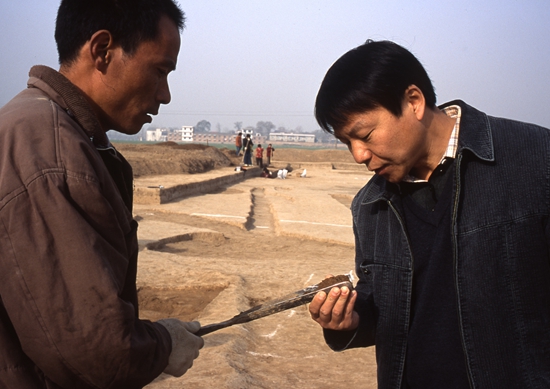Henan excavation site yields clues about China’s origins

Professor Xu Hong is examining the soil texture in the Luoyang shovel at the site.
Locating a center of power is crucial to establishing whether or not a site functioned as a capital city. A center of power can be identified based on the presence of several archaeological phenomena, such as a restricted area for rulers and buildings that are unnecessarily large, Xu said. Of the dozen or so large and medium-sized buildings found at Erlitou, the building No. 1 covers the biggest area, and it dates back approximately to the era of the imperial city. Larger and more complicated than any that came before, the building was constructed on rammed-earth foundations, covering an area of 10,000 square meters.
“Studies on history of early civilizations show that the first batch of cities that took form in the agricultural culture all had a monarchy. These cities represent a new model of society in human history due to their reliance on external environment. If the residents were all peasants, such a reliance would not exist. But with the advent of a ruler, there would be a group of people around to serve him or her,” Xu argued.
In most cases, a large tribe in the pre-historical period had no more than 5,000 residents, and a settlement in the Erlitou period usually was home to fewer than 1,000 people. However, Erlitou, with 20,000 inhabitants, was the largest settlement seen in East Asia at the time and its size marked the formation of a mature state-level society.
The Erlitou site is the ruins of the oldest large city among East Asia’s Bronze Age settlements. It was a centralized state of the period. The Luoyang Basin and the Central Plain, the birthplace of Erlitou culture, constitute the area of the “earliest China.”
“China is a concept that developed from nothing and became increasingly extensive. It is not contradictory to consider Erlitou to be the earliest China while stating that China has a history of more than 5,000 years. If we compare ‘China’ as an infant, Erlitou is her birthplace and the civilizations prior to it performed the preparatory work, such as the meeting of the parents and fertilization of fetus,” Xu said.
In his book The Earliest China, Xu suggested that Erlitou was one of numerous centers at that time, but its social and cultural circumstances as well as its enormous influence have undoubtedly made it a landmark culture of the period.
A lot of treasure was unearthed in a noble tomb in early 2012, including bronzeware, jade, turquoise and seashells. Xu found a 70-centimeter piece of turquoise that stretched from the owner’s shoulders to crotch, which is much longer than common turquoise bronze jewelry. Xu felt that the relics would become increasingly endangered at the site, so the remains of the turquoise along with the earth were transferred to Beijing. It turned out to be a well-preserved dragon-form artifact with white jade eyes that can be seen as a “national treasure.”
All the Erlitou relics had stories, but Xu is proudest of his discovery of China’s first urban road network and palatial town. In his doctoral dissertation, Xu explored the development process of early Chinese cities, and he found that some had no walls to protect the area outside the palatial town. Erlitou has no outer enclosure as well, but the palatial town had to be walled to enforce its role as a center of government and dedicated place for functions of the royal court.
Xu located the eastern wall of the palace area in 2003 after the building No. 2 and a main road were excavated by his predecessors. By 2004, all the four sides had been found, and archaeologists heralded the discovery of China’s first “forbidden city,” which covers an area of more than 100,000 square meters and has a history of about 3,700 years.
In later dynasties, most Chinese cities would build enclosures. In Xu’s words, Erlitou is closer to a “capital city.” It didn’t have enclosure except for walls used to protect the palatial town. In his book The Tradition of Non-fortified Primary Capitals in Early China, Xu wrote that most capitals of early Chinese kingdoms from Erlitou State—late Xia Dynasty or the Shang Dynasty—to the Han Dynasty had no walls outside the palatial town.
The third head of the Erlitou fieldwork team, Xu joked that “People believe the three directors of Erlitou excavation are increasingly incompetent because they are more and more uncertain about the site. The first director suggested that it existed in the Xia and Shang dynasties while the second director argued that most of its existence overlapped with the Shang Dynasty. When it comes to me, I have no idea. We can only say that it maybe, probably and most likely is a Xia capital.”
The academic debate has lasted for over half a century, but Xu never participated in it. He said that “It is better off to spend the time in finding detailed and reliable archaeological materials.” Xu cited the words of an author Zhang Chengzhi who majored in archaeology that the exploration of archaeology is endless. Archeologists undertake their work with the intent of getting a glimpse at ancient people and understanding their behavior or even their feelings by investigating cold remains.
The article was abridged and translated from China Youth Daily.
